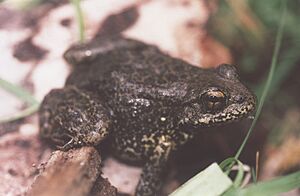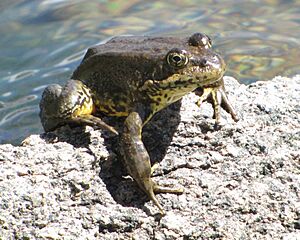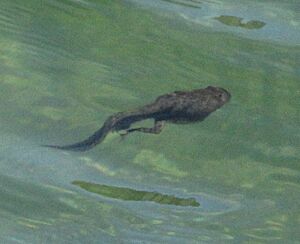Sierra Nevada yellow-legged frog facts for kids
Quick facts for kids Sierra Nevada yellow-legged frog |
|
|---|---|
 |
|
| Conservation status | |
| Scientific classification |
The Sierra Nevada yellow-legged frog (Rana sierrae) is a special type of frog. It lives only in the Sierra Nevada mountains. These mountains are found in California and Nevada in the United States.
This frog was once thought to be the same as another frog, Rana muscosa. But in 2007, scientists found they were different. Now, Rana sierrae is its own species. It lives in the central and northern Sierra Nevada.
These frogs used to be very common. Their loss has greatly affected the environment. They were a "keystone species." This means they were very important for the health of both water and land ecosystems. They helped move nutrients and energy around.
Contents
What Does the Sierra Nevada Yellow-Legged Frog Look Like?
The Sierra Nevada yellow-legged frog is one of two mountain yellow-legged frog species. The other is Rana muscosa. Rana sierrae looks a lot like Rana muscosa. Scientists used to think they were the same. But they found differences in their DNA. This showed they were separate species.
These frogs live in or very close to water. They are usually just a few feet from a lake or stream. Their skin can be yellow or brown. They have brown and black spots. These spots can also look gray, red, or green. This helps them blend in with their surroundings. This blending is called cryptic coloration.
The frog's belly is a bright yellow. It can also look orange. Young frogs, called tadpoles, are black or brown. It takes them one to four years to become adult frogs. Adult frogs are about 1.5 to 3.5 inches (3.8 to 8.9 cm) long. Female frogs are usually bigger than males.
These frogs do not have vocal sacs. Vocal sacs are like balloons that some frogs use to make loud calls. But Sierra Nevada yellow-legged frogs can still make a clicking sound. They make this sound both in and out of the water.
During winter, these frogs hibernate. They stay at the bottom of frozen lakes. They may only be active for about three months each year. This depends on the weather.
If a frog feels threatened, it can make a smell like garlic. This helps to scare away predators.
The Life Cycle of the Sierra Nevada Yellow-Legged Frog
The Sierra Nevada yellow-legged frogs start to breed in the spring. This happens between April and July. The exact time depends on how high up in the mountains they live.
Female frogs lay their eggs in groups underwater. An average group has about 233 eggs. The eggs are attached to something in the water. This could be rocks, gravel, or plants.
The eggs hatch into tadpoles in about 18 to 21 days. These tadpoles then grow into adult frogs. This process can take from one to four years. Once they are adults, they can reproduce. This completes their life cycle.
Where Do Sierra Nevada Yellow-Legged Frogs Live?
These frogs live in mountain waters. This includes streams, lakes, wetlands, and wet meadows. They are found at high places, from 4,500 to 12,000 feet (1,370 to 3,660 meters) high.
They spend most of their lives in or near water. Water provides them with food. It is also where their tadpoles grow. These frogs live in both the eastern and western parts of the Sierra Nevada. Their range goes north of Lake Tahoe.
The area where they live has not changed. But their numbers have gone down a lot. This is because they are an endangered species. Other threats also harm their homes.
Adult frogs often sit on large rocks near the shoreline. Tadpoles like warm, shallow areas of water during the day. This is especially true where there are not many plants.
For breeding, they need ponds, lakes, or streams that do not dry out. These water bodies must also be deep enough so they do not freeze completely in winter. It is also important that these places do not have fish.
How Sierra Nevada Yellow-Legged Frogs Reproduce
Sierra Nevada yellow-legged frogs reproduce in the water. When they are grown up, male frogs will call for a mate. When a female arrives, the male will hold onto her back. As the female releases her eggs, the male releases sperm.
Fertilization happens outside the female's body. A female can lay between 100 and 350 eggs at one time. The eggs are laid in shallow water. They are not always attached to something at first. But they can become attached to plants or rocks in moving water.
It is very important that the eggs are laid in water that will not freeze over winter. If the water freezes in a breeding area, it can kill many generations of tadpoles. This can set back the frog population for years.
Why Are Sierra Nevada Yellow-Legged Frogs in Danger?
The Sierra Nevada yellow-legged frog is a vulnerable species. This means it is at risk of becoming endangered. Studies show that 92.5% of these frog populations have disappeared.
The main reasons for this decline are diseases and new predators. Shallow lakes that dry up in summer also put these high-mountain frogs in danger.
One big problem is non-native trout. These fish were put into mountain lakes where they don't naturally belong. The trout eat many of the frog tadpoles. They also compete with adult frogs for food. Areas with trout have seen big drops in frog numbers. When trout are removed, the frog population usually goes up.
A serious disease called chytridiomycosis has also wiped out entire frog populations. This disease is caused by a fungus called Batrachochytrium dendrobatidis (or Bd). When populations get this disease, they either disappear or are left with only a few frogs.
This fungus grows on the outer skin of adult frogs. It also grows on the mouthparts of tadpoles. When it grows on adults, it makes it hard for them to breathe through their skin. It also affects how their bodies control water.
The frogs also suffer from habitat fragmentation. This means that groups of frogs become separated from each other. This makes it harder for them to find mates and share genes.
How We Are Helping These Frogs
Yosemite National Park Efforts
In 2006, Yosemite National Park started a project to help these frogs. They began putting frogs into lakes that did not have fish.
In 2007, another project began. This project aimed to remove non-native fish from remote lakes. Once the fish are gone, native species, like the Sierra Nevada yellow-legged frog, can return to these lakes.





